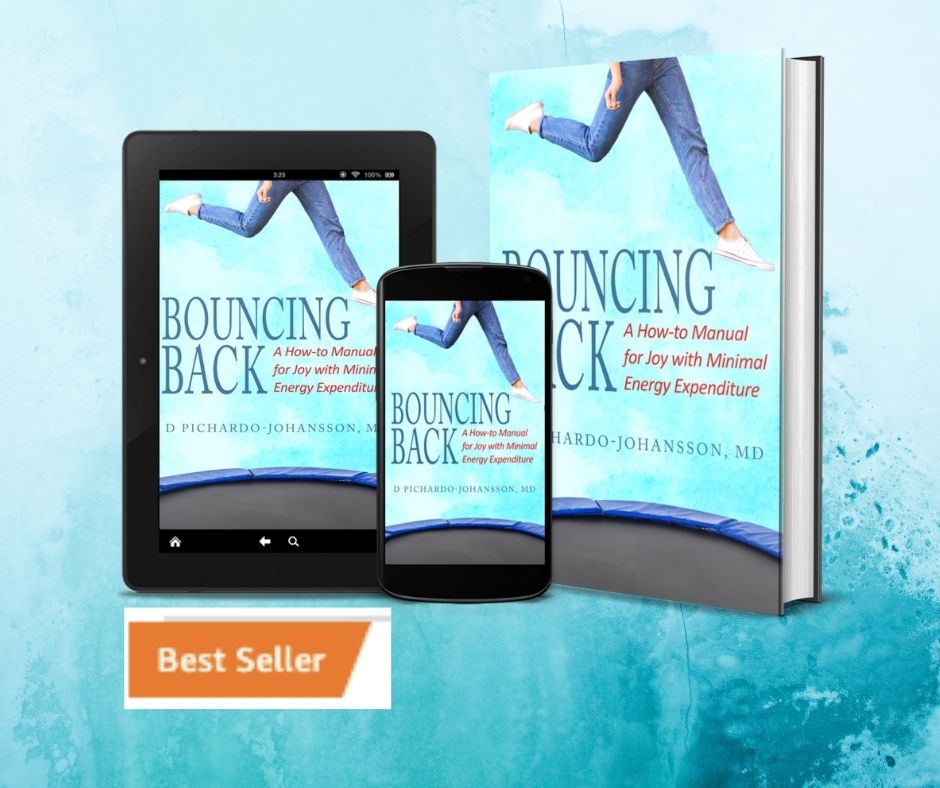How to Have difficult conversations in Five Steps
Difficult Conversations. Livestream Transcript
Introduction
So, before we begin, two disclosures. Disclosure number 1: you will notice that I have an accent. It’s from the Dominican Republic, and it hasn’t gone away after 25 years living here, so I don’t think it’s going away. But don’t worry. People repeatedly say that you get used to it quickly and according to my American born husband “then it becomes a source of endless amusement.”
(Music)
Hello everybody. I am doctor Diely Pichardo Johansson. I am a physician, life alignment coach and number one Amazon best selling author. Or as I prefer to call myself: I am an oncologist who after becoming a cancer survivor decided, “Life is too short. I don’t want to make a living fighting death anymore. I’d rather make a living celebrating life.”
And now I am a life alignment coach. I specialize in high achieving women and self-proclaimed people pleasers. I don’t like that word, I prefer to say that I specialize in very loving and giving people who sometimes overdo it with the loving and the giving and forget to take good care of themselves. And I teach these wonderful people to reconnect with their real voice, so they can gain the clarity, the power, and the confidence to design and live the life they really want to live. And speaking of the life you really want to live. I wanted to record this outside to show you a little bit of green from Florida if you happen to be in a cold state.
Coming to Florida was one of my big dreams, because I grew up in a tropical island and after seven years in the Midwest, the winter was killing me. So every time I can, I like to be outdoors. I am sitting here in my dream house, which my beloved soulmate husband and I remodeled completely. It used to be a a ruined 1950s home and we updated it, renewed it and expanded it completely eight years ago when we got married— in order to have enough space so we could accommodate my four children and his decades as a bachelor.
And I’m going to tell you that it takes more than the right space to create a mixed family.
More than the beautiful place, you need love, you need some trial and error and you need tons of communication. So this is what this stream is about. Today I’m going to be talking to you about five steps to Master Difficult Conversations both at home and at work. And I should have said five steps and a bonus tip because I’m going to be giving you a bonus tip that helps a lot with that too.

My Intention
My intention for today is that you walk out of here with skills that you can use in all areas of your life [to master difficult conversations]. And you can use it for very serious conversations (I’m going to be using the example of asking for a divorce or giving notice at a job where you are unhappy, both things which I have done.) But you can also apply this to the small day-to-day things like learning to say no when a colleague is asking you to do something you don’t want to do.
I encourage you to try first with the small things, maybe even by Email, and then work your way out to the bigger conversations. But my intention is that, by the end of this talk, you have skills that allow you to set healthy boundaries and ask for what you need and what you want. So, even if the other person doesn’t give it to you, at least you have created a healthy habit of keeping a clean slate—you have expressed what you need so you’re not accumulating resentments inside you that can lead to problems in the future.
Having difficult conversations regularly can help you keep a clean slate.
[I was helping] one of my beloved clients— I’ll call her Doctor D— through these steps to have a very serious conversation, quitting a job she hated (and it went wonderful). She used she tell me, “Diely, I don’t have a middle ground. I either never know what to say and I’m quiet— or I resort to verbal violence and I scream and yell.” And I tell her: don’t worry, the more you practice this style of communication, the more likely you are to be calm when you talk. Because you are not working on five years of grudges, you are keeping a clean slate and then anything all this ancient history never to be mentioned again.
Disclosures:
So, before we begin, two disclosures. Disclosure number 1: you will notice that I have an accent. It’s from the Dominican Republic, and it hasn’t gone away after 25 years living here, so I don’t think it’s going away. But don’t worry people repeatedly say that you get used to it quickly and according to my American born husband “then it becomes a source of endless amusement.” That was disclosure number one.
Disclosure number two is: It goes without saying that one of the most important parts of communication is listening. Active listening is critical. This talk, however, was designed for the people I work with. People who need help talking. They have already been listening quite a bit, but they have not been expressing themselves. So you will see that I’m going to focus a lot more about talking than listening but if you need help with active listening, type it in the comments even if you’re watching this in the replay so I can plan a live stream about that.
Difficult Conversations: Bonus Tip:
Okay so let’s get started, and as I promised, I’m going to get started first with the bonus tip. And the bonus tip is: You will notice that the steps I’m going to share with you start with two steps to prepare yourself before the talk. Then there’s two steps that happen during the talk and a step that overlaps both before and after. That means that, ideally, you want to have set a date for this conversation ahead of time so you are prepared.
But what happens if the decision is made for you? If your soon to be ex ambushes you [and says], “We need to talk. Are you going to leave me?” Or if your boss, who suspects already you’re interviewing elsewhere, corrals you in your office? In that case, you want to make sure that you follow this bonus tip. And this bonus tip has worked miracles with some of my clients most recently doctor B and Doctor D. They said “I can’t believe I didn’t know this.” I want you to remember this and if you only listen to this, you’ll be better off at the end of this recording.
Are you ready? This is the bonus tip memorize these words:
“I will get back to you.”
That’s it.
Very simple. You are not obligated to give someone an answer immediately.

That works either when someone is trying to pressure you to cover for them, or take their job and you tell them, “I’m sorry, I think I have something planned, I need to check my calendar and I will get back to you.” And it also works if someone is pressuring you to start a conversation you are not ready for.
Repeat these words. “I hear you. I agree with you, we need to talk. But right now is possible. I’ll get back to you. Let’s set a time and a date where we are going to do this.” Make sure that you put this in practice so you can prepare ahead of time for your conversation.
Now with no further ado, here are the five steps. And step number one is something that I hope you’re doing everything in your life. And is: Set an intention.
Difficult Conversations Step 1: Set an Intention
Know what you want ahead of time. Make sure that this doesn’t become just a complaining [a venting session]. What do you want to accomplish from this conversation? Maybe this is the conversation when you’re going to ask for the divorce. Or maybe not. Or maybe you are not ready, or you know the other person is not ready, and it’s only a conversation to let them know that you are considering a divorce.
Perhaps this is the conversation when you’re going to give notice, or maybe not. Maybe you’re just going to express what is going wrong and ask for something to correct it. Know what you want ahead of time, and if you still don’t know it, don’t worry, the second step is going to help you clarify this, okay?
Difficult Conversations Step 2: Deflate the feelings ahead of time
So number two is deflate the feelings ahead of time.
If you are like most of my clients, by the time you’re going to have this conversation you have been holding inside resentments and things you wish you would have said. Make sure that you have vented them all ahead of time so you’re not distracted, and this doesn’t become just a venting session. You may say “Well, I plan to have a little crying session ahead of time.” Or “I would just punch a pillow or a punching bag.” That’s fine if it works for you. But I invite you to do something more sophisticated than that.
The venting letter:
I want you to take pen and paper and write a letter you never intend to send to this person. And in this letter, you are going to express not only your favorite negative feelings, sadness or anger, but all of them. “I am sad because… I’m disappointed. I am angry. I am scared. I regret…” All the negative feelings. You’re going to deflate them and if there’s something else in the past that you’re resentful about, mention it all there until you feel a catharsis has happened.
But I don’t want you to end only there. The reason to do this is because I want you to take all this which is what you don’t want and I want you to translate it into what you want.
Examples:
For example, if in this letter you said, “I am sad and heartbroken because you cheated on me.” That’s what you don’t want. “I don’t want a husband who cheats on me.” [This translates to] “I want faithfulness, I want respect, I want to be in a relationship with someone I can trust.”

“I don’t want a boss who cheats me with money” [translates to], “I want someone who is ethical. I want to work in a place where I’m respected and part of a team.” So as you do this, not only you create language of what you are going to tell the other person so you can ask for what you need but you also wash away some of that negativity and recalibrate yourself into positivity.
And don’t put the letter away yet because the the next step, we’re going to use it again.
(Recap so far):
So, step number one, set an intention for the conversation. Step number two, deflate the feelings ahead of time by venting, writing a a letter saying everything without filters that you wish you could say and use it to identify what you want. So, step number number three is the one that overlaps the before and the after and is anchoring yourself.
Difficult Conversations Step 3: Anchor yourself.
Imagine that there’s a storm and winds [are blowing,] and you are going to be setting posts in the ground to anchor yourself, so you are not blown away. That’s what we want to do if the conversation starts derailing into “Oh, you did this” and “She said, he said” and old resentments. You want to be returning to your anchors. One of them is your intention if the other person starts going into old history you say, “I’m sorry. I hear you, but we are not talking about that—we’re talking about this” ( your intention).
The next anchor I want you to use is the universal value that you can never go wrong with and is love. And since some of these conversations are not for loving relationships, the way the path to love in this case indirectly is gratitude. At the end of this letter that you’re writing, [when you’re done] venting all the negatives, I want you now to spend as much time talking about all the good things that have come from the relationship with this person. Even the worst boss in the world paid you money, which allowed you to support your family and pay debts. Even the worst romantic partner in the worldwas probably a vehicle for good things to come into your life. “I am grateful for the trips we had, the gifts you gave me, the things I learned from you.” Find every [reason for] gratitude you can, and trust me, it’s possible.
Love Anchor Example:
I have a client, I will call her Elle, who had to confront and divorce a husband who had cheated on her, had been physically violent—had pushed her away and hit her in an argument—and had used racist slurr to talk to her. So you could say this was a certified jerk, unredeemable. [You could argue there was] nothing that she could do to reconnect with love. And yet she was able to reconnect with a memory of gratitude. [She evoked] the memory of when she was giving birth to their first child. They lived in England, away from their family, she had no other family in town. And even if he was terrified of blood and doctors, he went into the delivery room with her and held her hand when she was delivering. She was able to reconnect with that memory of past love and gratitude, and that carried her through all her divorce proceedings.
Other Anchors for Difficult Conversations:
If you are really incapable of finding gratitude and love for this person, see if you can anchor in self-love. “My anchor is that no matter what they tell, me even if they’re gaslighting me, I will return to my self -love. “But I deserve better than this.”
Or [alternatively, anchor yourself in] a value. I cannot over emphasize how important it is to know your values. You really want to make sure that you know your values. If you don’t know them yet, type the word “values” on the comment box and I will be happy to send you a resource about that.
But in this case, a value would be a truth that is indisputable. So if someone is gaslighting you or someone has an overpowering personality, you know that there is a truth that you are holding to.
Example of anchoring in a value or indisputable truth:
For example, my client Doctor S was a surgeon who was having a lot of trouble with his partners. They were canceling his clinic without his permission; they were changing the OR schedule and leaving him hanging; they were assigning patients for him to follow that he didn’t know… He was very frustrated about this disrespect, but every time he tried to talk to them, they would say, “Wait a minute. So you are not a hard worker enough? You are not a team player? So you are not someone we can count on?” And they would derail him.
So, we were able to find a undisputable truth for him and in this case it was “The safety of the patient is sacred.” Period. End of discussion. And it didn’t matter [if they] say “Oh, you have to be a good team player.” [Answer]: “I’m sorry, when you add a patient to my schedule I wasn’t expecting and I don’t know, and I haven’t prepared for it, you put the safety of that patient in risk. That is not possible.” “I’m sorry, when you cancel my clinic without telling me, when you leave me hanging in the OR, that puts the safety of the patient in danger. So end of conversation that’s not acceptable.”
I want you to find something like that: your ethics, your self-respect, the value of honesty… something [undeniable true] that you feel has been violated in this situation and that you’re going to be holding to.

Okay? So that was the step number three, anchoring yourself.
Difficult Conversations Step 4: Use “The Sandwich.”
I’m going to introduce you to a technique that has changed lives and saved marriages. My friend my client Maria attributes this to saving her marriage and you can read her testimonial on my website. She says that “she saw her husband change in front of her eyes.” [This was] just by changing her communication style, and that was without me ever meeting her husband. And this step number four that I want you to learn is the sandwich technique.
You may have heard something like that before, but in this case this is a little different.
I want you to take that anchor of love and gratitude that we created on the previous step and I want you to start your conversation with that.
By aligning yourself with love and gratitude and starting with something positive you not only come across (and it has to be sincere). You not only come across as a higher version of yourself, but you also open the receptivity for the other person. [That’s] because you transform your non-verbal communication, your gestures. You transform [into a higher version of] who you are, and in by doing that, the other person becomes more receptive and shows up as a higher version of themselves.
The Sandwich in three steps. Positive-Negative-Positive.
So step number one [in the sandwich]: you open with positivity. [This can be] gratitude, love, sincere praise even owning or acknowledging your part, something you did wrong. Open with positivity.
Then the middle of the sandwich is your opportunity to express yourself and what your complaints are. But I invite you to spend the majority of the time on the solution and not the problem. Talk about what you want, instead of what you don’t want. Remember that list we made in your preparation letter? “I need a partner who I can trust, who respects me, who is sincere, someone who’s faithful to me” (Instead of “you are a cheater or you’re a complainer”)
You see the difference? Spend most of the time talking about what you want, not what you don’t want. But yes, this is your opportunity to express your discontent if that is the intention you set.
And after that, the [last] layer of the sandwich, you end with positivity again. You thank them you give them sincere praise for their attention, you own your part…
Using the sandwich in difficult conversations. Example.
And this is an example of how it goes. Positive, negative, positive. You start [saying something like], “Sweetie, I want to tell you that I love you. I want to tell you that I’m really grateful for everything you have done for me on the over the years. You have been a wonderful partner and I if I don’t say it enough, I want to say that. And, (use and, not but) I am concerned about your drinking. I want to tell you that I need in my life a partner I can trust and I can rely on, and when you drink too much that makes me afraid that I cannot count on you.” And after you have expressed what you want and what you need, you end with positivity. “I thank you for listening to me. It means a lot to me that we can communicate openly.”
That technique, positive negative positive, has changed lives has been has done wonders with my clients. You can read some testimonials on my website.
Step Five: Anchored Listening:
And now we get to the final step, step number five and that is: listen, but remain in your anchors. (Like I said before, if you need help with active listening type it in the comment box and I will create a live stream for that.)

Make sure that you do listen to the other person, give them a chance. I bet you that if you followed the previous steps, [you both are] going to show up in a higher version, and the emotional charge will be less.
But still, I want you to breathe. Let them talk and remain anchored in that love and in those values.
So if this person starts derailing themselves [going to past grudges, saying,] “Oh but one day in in 2015, you did this [or that] to me…” You active-listen, (you mirror, validate, summarize) but you return to your anchor.
[Example]:
“I hear you. It must suck to have trained someone that now is quitting. I hear you. It must suck to hear that your wife wants a divorce when you’re in your 50s and it’s harder to meet someone else. I completely understand that you’re upset. And all I know is that to me honesty is important, and I need a partner I can trust.” So you Keep repeating [your anchor] as a mantra: Your intention, what you want, your love and gratitude, all those anchors. Return to[them], so you can then completely listen, but not be derailed from what you needed to express.
Recap:
Okay? So in summary, that’s five steps with the bonus tip. First, make sure you take control of the time. Tell them “I’ll get back to you.” Make an appointment. Make sure you’re not ambushed. You do not have to have a conversation you don’t you’re not ready to have.
Step number one, set an intention. Know what you want to accomplish. Step number two, deflate the feelings ahead of time. Vent the negativity but to use it to understand what you want and make sure you end this venting letter with gratitude. Step number three, anchor yourself. In love, self love, gratitude, your values, a truth that you know is indisputable… You can return to [these anchors] if the other person is gaslighting you or overpowering you.
Step number four, use the sandwich technique.Positive, negative, positive. And last step, listen. Breathe through the waves, allow them to explain to themselves. Listen, but remain anchored in your values and in your intention.
Final Words:
I know that there is a lot more than this that goes into difficult conversations. There are more techniques that I could share with you, but it even before you have the conversation, you need to have enough self-awareness to even know that a transgression has occurred. You need to have enough self-love to even want to speak up for yourself. You need to know what you want.
There are so many steps that are implied in having these conversations and that those are other areas where I can help you. And I wanted to talk to you about working together I have had amazing results with my one-on-one clients and now in order to touch more people I am expanding to groups so I can welcome more people at the same time and if you would like to get more information about that please [contact me at joyfullysuccessfulcoaching@gmail.com or visit my website to request a complimentary call]. I have a video I can share with you about my group, or I we can set up a call to talk more about your specific needs and how I can help you.
How I can Help You
I have tons of wonderful testimonials I invite you to read on my website. For some reason, the majority of my recent clients have been surgeons who are self-proclaimed workaholics who are now [thinking], “I need more in my life. I have done enough following training and now it’s time for me to enjoy.”
I have another group of clients who are women recovering from divorce or making decisions about whether to divorce or to save their marriage. Some of them have saved their marriage like my client Maria. Some of them have in gone to a divorce and be extremely happy about it like my client Kim. Some people come to see me after the divorce to help design their new life or to help get them back into the dating life, like a current client I’m working on I’ll call her A. And some other people are now becoming empty nesters or entering a new stage in their careers where their finances are okay and they want now passion in their lives. Or they want to take their hobby into an a source of income or a business, and that’s another group of people I can I’m helping with.
You can read some of those wonderful testimonials on my website like my client Doctor B, who says that I have been critical on her balancing her life as a surgeon, a business partner, a mother and a romantic partner. Or my client Doctor Frances who says that before she worked with me “her life was messy like the junk drawer where you throw everything and now she see things more clearly” or like my client Christina, an attorney, who says “I could have learned and figured these things out [on my own], but it would have taken me 30 years instead of 6 months.”
An Invitation
So, I really invite you to continue this conversation. Let’s see how I can help you to have that mindset change and that identity revamping for you to be the [a new type of person]. [Someone] who cares enough about herself to take care of herself, to have these difficult conversations.
If You Enjoyed This Post, Please Share it Using this Link:https://joyfullysuccessful.com/how-to-have-difficult-conversations/
If You Enjoyed This Post, You May Also Enjoy:
Assertiveness in Communication.
Avoiding Family Fights During the Holidays.


